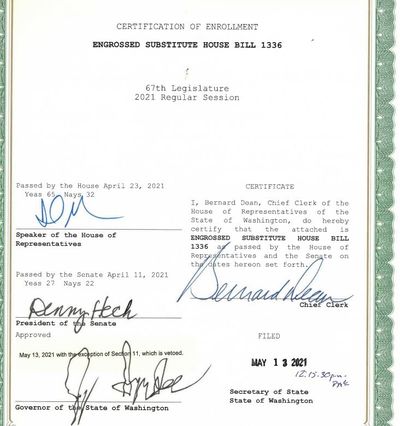This column reflects the opinion of the writer. Learn about the differences between a news story and an opinion column.
Spin Control: Inslee used both hands to pass the buck to Wyman on dual broadband bills

In nine years as governor, Jay Inslee has signed some 2,800 pieces of legislation and vetoed about 50, so you would think by now he’d have the process down of deciding which things should become law and which shouldn’t.
This year, however, confronted with a problem created in large part by the Legislature that passed both a House bill and a Senate bill on the same topic, he decided to add a new wrinkle to the process that none of his 22 predecessors tried.
Or probably ever considered.
Inslee signed two bills at the same time that aim to expand broadband services in the state. One with his right hand and one with his left. While he signed 18 other bills that day under the watchful camera of TVW, he did the double-signing off camera.
Possibly to avoid looking silly.
Considering Inslee is right-handed and does not boast of being ambidextrous, the signature on the House bill he signed with his left hand is barely legible. If that signature was on a check, a bank would likely reject it. If he had signed his ballot envelope that way, his county elections office would make him do it over before counting the ballot.
The right-handed signature is no great shakes, but it’s probably no worse than what he does when doing a finger signature on a little space on the card reader at the checkout counter.
The reason for this not-so-sleight of hand is that state law says when two laws have contradictory language, the one passed most recently is followed to resolve the conflict.
While the broadband bills both aim to expand better internet services to many areas, they do have a few differences. Probably the most important: Senate Bill 5383 gives public utility districts and port districts strong authorities to expand into “unserved areas,” while House Bill 1336 allows those districts plus smaller cities, towns and counties to expand those services.
Inslee’s simultaneous signing meant he wasn’t deciding which bill would become the more recent law, passing that responsibility off to the next step in the law-making process, the formal filing of the signed bills by Secretary of State Kim Wyman. Inslee’s staff walked the paperwork down the hall to Wyman’s office, both bills in a single stack so they would hit the counter at the same time and with a note on top that said they had been signed at the same time.
The Senate bill, which was on top, was stamped received at 12:15:10 p.m., the House bill, which was on the bottom, was stamped in at 12:15:30 p.m.
Wyman balked at trying to determine what order the bills should go to the office that formally enters them into the state’s official law books, the Revised Code of Washington, because that would ultimately determine which was the most recent.
Under state law, she believed her job on legislation is strictly ministerial, Wyman told the Thurston County Superior Court. She wasn’t sure that she has the legal authority to take an action that would determine the fate of any conflict. If she didn’t, she asked for guidance from the court.
“I wanted to make sure we weren’t overstepping our authority,” Wyman told TVW’s Mike McClanahan recently.
Superior Court Judge Mary Sue Wilson ruled Wyman could make that determination and declined otherwise to get involved. So her office checked what happened before Inslee’s two-handed maneuver and looked at the time when the bills were signed by others involved in the official process, the president of the Senate and the House speaker.
Wyman said she didn’t study the two bills in an effort to figure out which was better, and didn’t talk to supporters or lobbyists, who were calling her office. “I really didn’t want to know the content of these bills,” she said last week on TVW’s “The Impact.”
The Senate bill was signed on April 24 in both the House and Senate; the House bill on April 24 in the House, but on April 25 in the Senate. The office determined the House bill was the newer legislation and filed the two bills accordingly.
Which is what would have happened if Inslee hadn’t tried to be impartial or cagey – hard to tell exactly which – and simply not done anything. Under state law, a bill becomes law after a certain point if the governor neither signs nor vetoes it. The two bills would have gone to Wyman’s office for processing, they would have checked the times when they were signed by the top legislative officers and the House bill would have been deemed the more recent.
The odd thing about this is that Inslee seemed to ignore one of the mantras he was fond of repeating on the presidential campaign trail: “To govern is to choose” – unless you consider not choosing a choice.
